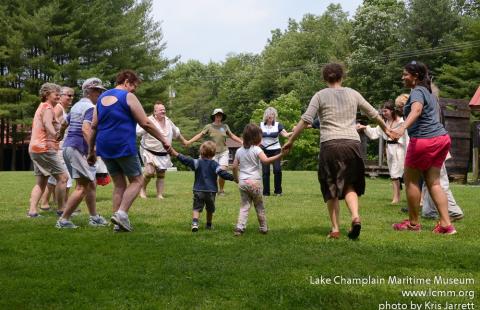What were the specific goals of this creative economy project? Describe the community development challenge or opportunity that your project was designed to address:
Our project goals have evolved over the past 12 years since the event began. Today our goals are to increase the visibility of the Abenaki community, educate the public about Abenaki history and culture, to promote Abenaki art and artists.
For LCMM, the goal from the outset was to ensure that the Museum’s programming and exhibitions would reflect the enduring presence of Lake Champlain’s first navigators
If the goals change over time, please describe how:
From the beginning, VAAA wanted to increase the visibility of the Abenaki community and quickly understood the need for educational programming. Each year we evaluate internal needs and future growth opportunities. Significant growth occurred when Abenaki tribes received state recognition. Both LCMM and the Abenaki community made a strong case that they could not effectively interpret Abenaki culture for the public until the Abenaki had legal sanction through state recognition. Understanding recognition issues remains central to public interpretation at the event.
Who was involved in this project and what did they do? (be sure to include the partners from outside of the creative sector and how local voices were included):
In 2007, as the Champlain Valley began to anticipate the 2009 Quadricennial celebration of Samuel de Champlain, LCMM worked with the Abenaki community to present the contributions and culture of the lake’s First Navigators. In 2008 & 2009 a wide array of commemorative events were organized by civic groups, academic, cultural, and arts organizations, with business sponsorships. The francophone community was very involved. Regional marketing ensured public awareness. After the “Quad,” in 2010 we faced pivotal decisions – would the event continue, and how?
In 2010 – 2012 the event was primarily organized by Abenaki scholar Fred Wiseman, working with individual artists and members of the Elnu Abenaki Tribe.
• In 2011 and 2012 four Abenaki tribes were recognized and the event was renamed Abenaki Heritage Weekend (previously, we could not legally refer to the Abenaki so it was called the Native American Encampment).
• In 2013 the intertribal VAAA organization was developed as a creative hub of Abenaki artists carrying traditions into the future. VAAA became lead partner with LCMM to develop an annual exhibit featuring the work of contemporary Abenaki artists, and to organize and present the Native Arts Marketplace.
• In 2014 we previewed and evaluated the exhibit “Parley and Protocol: Abenaki Diplomacy Past and Present” being developed for the National Park Service at Fort Necessity
• In 2014 the Vermont Commission on Native American Affairs (VCNAA) approached LCMM/VAAA and offered to partner and co-host the event at LCMM; while unable to provide direct financial support VCNAA participated for three years, helping to publicize the event, and recommending sources to which LCMM could apply for support.
• In 2015, Flynn Center for the Performing Arts, Burlington’s lead performing arts venue, invited LCMM and VAAA to present a traveling exhibit in their fine art gallery and offer related educational programs and performances– intended to promote the Abenaki Heritage Weekend. The opportunity allowed us to expand the exhibit then under development. Alnobak: Wearing Our Heritage opened at the Flynn in 2017 and took on a life of its own, leading to widespread media coverage, production of curriculum materials, exhibit venues in three states, and new connections for future events and partnerships.
• In 2017 and 2018 VAAA was awarded grant support from the Haymarket People’s Fund to work towards anti-racism and social justice. This grant support helped underwrite some of the presentations at Abenaki Heritage Weekend, working toward the goals “to make our vibrant culture visible and to help Abenaki people and communities to overcome the damage sustained by centuries of institutional racism and social injustice. Ignorance of our existence and culture is the root cause of these problems. We are working towards a time when museums, galleries, and schools interpret and/or acknowledge our people, arts and culture. Our educational programs can reach into the non-Native community of New England to bring together people of diverse racial, economic, religious and social backgrounds. The Alnobak: Wearing Our Heritage Project will bring attention to these social justice issues and begin a dialog for systemic change on a larger scale throughout New England.”
How does this project relate to a larger community development strategy?
At Abenaki Heritage Weekend, Abenaki individuals and groups of visual and performing artists showcase their creative works within a wider cultural context provided by Abenaki scholars, cultural historians, and leaders. Visitors of varied ages and backgrounds make deeper connections and gain more nuanced understanding of Abenaki culture through dialogue and observation. Abenaki presenters are able to test strategies for both creative work and public presentation, and this regular collaboration among Abenaki tribes has led to further partnerships.
What projects or places, if any, inspired your approach to this creative economy project?
This project was originally inspired by the approaching anniversary of the 1609 encounter on Lake Champlain between French explorers and the Abenaki and other indigenous people who were the first navigators of bitawbagw (Lake Champlain). Initially, the event was very focused on this specific encounter, and now the event has grown into a celebration of enduring regional culture.
